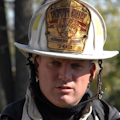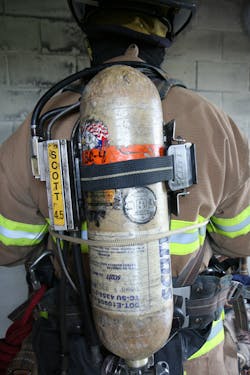Emergency Egress for Fireground Survival: The Rope Slide
Your crew is performing a primary search of the floor above the fire when you hear the evacuation tones over your portable radio. Turning to exit down the stairway, you suddenly realize that your crew is cut off from the stairs by rapidly spreading fire conditions. Conditions are worsening and the heat is driving you and your crew lower to the floor. You are able to make it back into a bedroom that has a window, but there is no ladder or crew visible outside. One crewmember produces a rope out of their turnout gear pants pocket. Are you and your crewmembers properly prepared to safely exit?
The fire environment faced by today’s fire service presents many additional challenges and dangers as opposed to the fire environment of the past. Fuel loads have increased and changed significantly affecting the fluctuation of the time/temperature curve as it relates to hostile fire conditions. Time frames to reach flashover conditions in today’s environment have been demonstrated to take place in as little as three to 3 1/2 minutes. This change in fuel loads, combined with other factors such as construction methods and features (both legal as well as illegal), is causing an issue when it comes to fireground survival.
Firefighter Survival Training
Looking back, from 2002 to 2009 we have averaged 112 line-of-duty deaths each year. The best way to overcome this problem is to focus on the “key” areas of our job to prevent us from getting into trouble on the fireground. A lack of recognition of key aspects related to fire behavior continues to be one of the top five reasons firefighters get killed or get into trouble on the fireground. Everyone working on the fireground needs to be aware of the conditions that can create the need for emergency escape and prevent those conditions from occurring. Our firefighters must be properly trained and prepared to meet these challenges.
High-impact, hands-on self-survival and rapid intervention training can cause injuries to firefighters if the proper precautions are not taken. Because of this, many chiefs and training officers will not allow their members to train on techniques such as the emergency egress rope slide, which in the opinion of this writer is more of a disservice. Techniques such as this have been proven to make a difference by saving countless firefighters’ lives on the fireground. If trained on with the proper safety measures taken, they can be accomplished relatively safely.
Training is the one and only time that we have control over the conditions and environment that we work in. Safety parameters for training in these techniques include the use of a rated safety line that is attached to a rated Class III safety harness worn on the firefighter. This line shall be belayed in order to prevent any accidents that may occur. This safety line shall be set up and operated at all times by a member properly trained to do so. Safety lines shall also be checked prior to each and every participant taking their turn.
A simple method for rapid escape is the rope slide. There are many variations to this procedure. The one chosen for this piece is the “bare bones” procedure that is simple and requires minimal equipment.
Step-by-Step Instructions
The first and one of the most crucial steps involved when using a rope slide is the establishment of an adequate anchor. This can be very difficult when the distressed firefighter may be working in adverse conditions. The major consideration when establishing an anchor is that it will support the weight of the firefighter during the escape.
The rope should be wrapped behind the back, around the self-contained breathing apparatus (SCBA) as high under the arms as possible. Both ends of the rope should be in front of the body (see Photo 1).
The firefighter should get into a position that allows for egress through the window while maintaining tension on the rope. Both hands should grasp the rope and will be used to control the slide (see Photo 2).
The firefighter should make certain to grasp the rope at a point that will allow his hands to clear the windowsill and avoid being pinched beneath his bodyweight (see Photos 3 and 4).
With the anchor secured and the rope grasped in front of the body in the proper wrapped position, the firefighter straddles the windowsill and begins to roll out of the window (see Photos 5 and 6).
As the firefighter rolls out of the window, he transfers his weight from the windowsill to the rope system while maintaining control with his interior leg (see Photo 7).
When his weight is transferred, he controls his slide by adjusting the grip of his hands. The friction that is created by the rope being wrapped around the upper body and SCBA creates a friction device that controls the descent (see Photo 8).
The firefighter should control his descent in a slow and deliberate manner and should avoid any shock loading to the rope system.
Keeping the arms and hands close to the body increases the braking effect (see Photo 9) and moving the arms and hands away from the body decreases the braking effect (see Photo 10).
Knowing your job and possessing a strong background in firefighting basics is the first and most important step that all firefighters should take when it comes to self-survival skills for the fireground. Everyone working on the fireground should be aware of the conditions that can create the need for an emergency escape and should be well versed on what is needed to prevent getting into a bad situation in the first place. Maintaining an open and progressive mentality and training with safety as the number one priority, firefighters can acquire the skills and confidence needed to react to an emergency successfully on the fireground. Is your crew ready for the challenge?
JEFFREY PINDELSKI, a Firehouse.com Contributing Editor, is a 20-year veteran and student of the fire service and is the deputy chief of operations with the Downers Grove, IL, Fire Department. Jeff is a staff instructor at the College of Du Page and has been involved with the design of several training programs dedicated to firefighter safety and survival. Jeff is the co-author of the text R.I.C.O., Rapid Intervention Company Operations. Jeff was host of the recent Preparing for Tomorrow's RIT Deployment Today podcast was a guest on the inaugural edition of the Training & Tactics Talk. View all of Jeff's articles and podcasts here. You can reach Jeff by e-mail at [email protected].
About the Author

Jeffrey Pindelski
JEFFREY PINDELSKI is the Downers Grove, IL, Fire Department Chief (Ret.) and has been a student of the fire service for more than 30 years. He served as a chief officer for more than 15 years of his career, during which time he directly managed every aspect of the fire department at one time or another. Pindelski holds a master's degree in Public Safety Administration from Lewis University and earned a Graduate Certificate in Managerial Leadership and a bachelor's degree from Western Illinois University. He is the co-author of "R.I.C.O.- Rapid Intervention Company Operations" and was a revising author of the third edition of "Firefighter's Handbook." Pindelski presented at numerous fire service conferences and had more than 55 articles published in trade journals on various fire service-related topics. He is a recipient of Illinois' Firefighting Medal of Valor.
